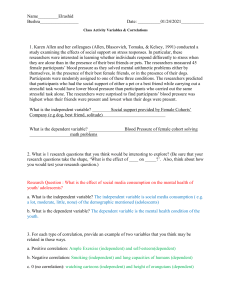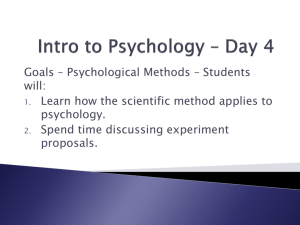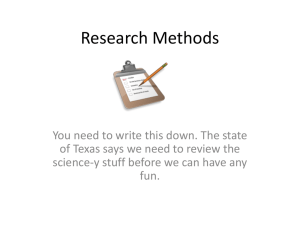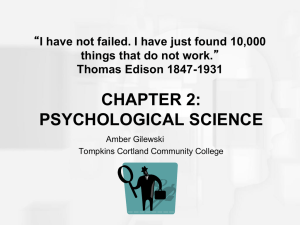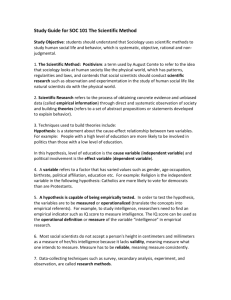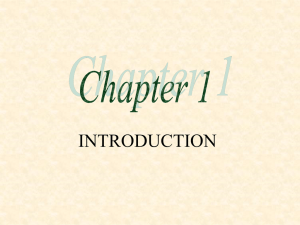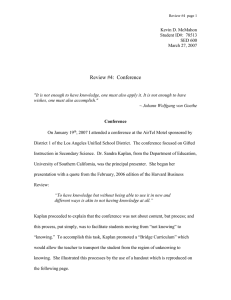Psychological methods
advertisement
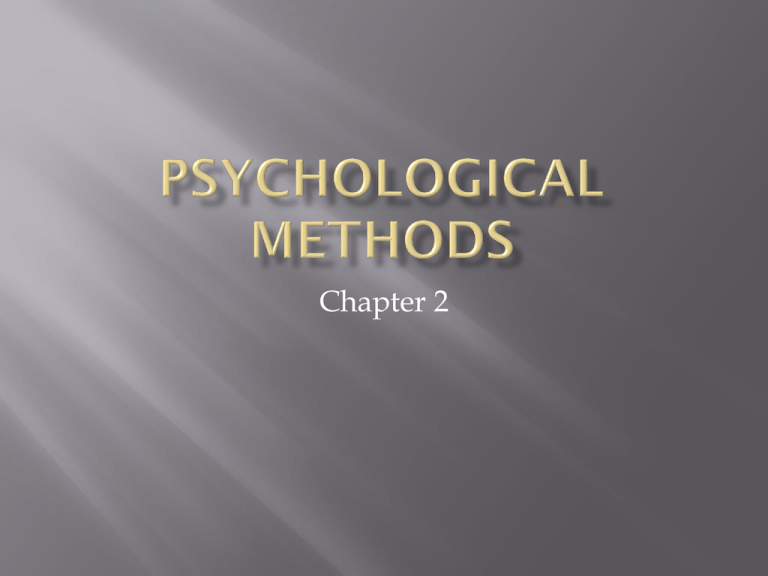
Chapter 2 Section 1 Forming a research question Constructs= things that can be assumed are there but cannot be seen directly (aggression, anxiety) Forming a hypothesis Hypothesis= educated guess Testing the hypothesis (various methods) Analyzing the results Look for patterns and relationships in the data Drawing conclusions Used in the validation of theories Replication Validation Study must be repeated with same results Study must measure what it’s supposed to New questions Process should lead to new questions Section 2 Survey- series of questions about a particular subject Written questionnaires or interviews *information may not be completely accurate Populations/Samples Target population- whole group to be studied Sample- small part of target population Samples Random- participants selected by chance; each member has equal chance Stratified- subgroups are represented proportionally Can’t make assumptions about other groups Bias- predisposition to a certain point of view despite facts Volunteer bias- people who volunteer have a different outlook from those who don’t Volunteers may be more willing to disclose personal information Volunteers may be more interested in research than others Section 3 Method Testing Case Study Description Several types of tests measure various elements of human behavior such as abilities, interests and personality Researchers conduct in-depth investigations of individuals or small groups Advantages Disadvantages Convenient method for researchers to gain insight into certain aspects of an individual’s abilities or behavior Does not always provide a complete representation of an individual’s true abilities or personality Provides insight into specific cases -Cannot be replicated -People may distort their past experiences -Researchers may encourage people to answer questions a certain way Method Description Advantages Longitudinal A group of participants are observed at intervals over an extended period of time Enables researchers to see how individuals change over time Time-consuming and expensive. Participants may not be available for duration of the study Researchers compare differences and similarities among people in different age groups at a given time Less time-consuming than the longitudinal method for studying changes over time Differences between the members of the sample cannot necessarily be attributed to age or development Naturalistic Observation Researchers observe the behavior of people or animals in their natural habitats Enables researchers to witness the behavior of people or animals in settings that are not artificial Researchers have no control over the setting or events that occur Laboratory Observation Participants are observed in a laboratory setting Cross-Sectional Enables researchers to precisely control certain aspects of the study Disadvantages Laboratories cannot duplicate real-life environments 20 months old= locked in small room kept in room until age 13 Contact: Mother (fed her) Father (beat her) Had older brother who was also beaten No one spoke to her and she did not speak Language after rescue: limited *critical time period for language development Genie the Wild Child Correlation= measure of how closely one thing is related to another The stronger the correlation, the more closely related the items being measured Positive and Negative Correlation Positive Correlation= one variable increases, the other one increases; one variable decreases the other decreases Negative Correlation= as one variable increases, the other variable decreases Positive Correlation Negative Correlation Limits of Correlation Describes relationships Doesn’t reveal cause and effect Section 4 Independent and Dependent Variables Variables= factors that can vary or change Independent variable= factor that researchers manipulate so they can determine effect Dependent variable= depends on something; what is being measured Experimental and Control Groups Experimental group= receives the treatment/manipulation Control group= don’t receive treatment Subjects are randomly assigned to groups Controlled experiment= Experiment used control groups and experimental groups The Placebo Effect Placebo= substance or treatment that has no effect aside from a person’s belief in its effect Stanford Prison Experiment Single-Blind Studies= participants do not know whether they are in the experimental group or in the control group Double-Blind Studies= both participants and researchers are unaware of who receives the treatment Required by FDA for new drugs People can remain unbiased Central tendency= number that describes the average score of a distribution (mean) Can also find median and mode Standard deviation= measure of distance of every score to the mean *Ethics= standards for proper and responsible behavior Research with people Limits the type of research that can be done Confidentiality promote dignity of the individual foster human welfare maintain scientific integrity records are kept private people more likely to disclose information and feelings Informed Consent restrictions prohibit studies that pose a serious threat to the physical/psychological health of participants Informed consent= people agree to participate in a research study after they have been given a general overview of the study Deception: When to use it… when they believe that the benefits of the study outweigh the harm individuals would have been willing to participate if they knew the benefits of the study participants receive an explanation after the study is over Ethics in Using Data how they produce, store and present data if data collected contradicts hypothesis, must be willing to discard hypothesis
